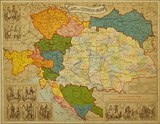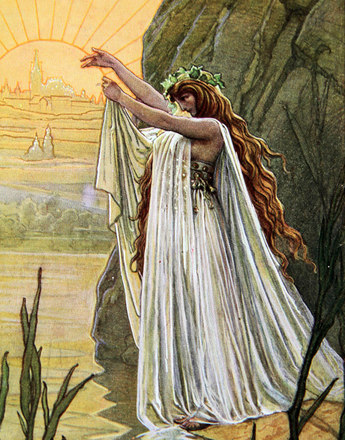Unity in diversity? The failure of the idea of a ‘greater Austrian’ nation
It soon became clear that the western European concept of the unity of nation and state could not be applied to the Habsburg Monarchy because of its ethnic, linguistic and religious multiplicity.
When confronted by the development of the new nations, the Habsburg Monarchy adopted a different approach from most of the large western European states. Although these were mostly also ethnically heterogeneous, they had forged a concept of the nation in which the smaller groups were absorbed into the larger whole. The best example of this is France with its concept of a grande nation that embraced all the citizens of the state whatever their ethnic background. Although the Habsburgs had overseen a largely successful process of state-building, with their endeavours to subject their dominions to centralized administration reaching a high point under Maria Theresa and Joseph II, they were not successful in forging a ‘greater Austrian’ state capable of transcending ethnic boundaries.
On the contrary, in response to the centralization programme there arose the idea of federalization; and the effective reaction to the utopian ideal of a German-led unified state as formulated in Joseph’s II’s reforms was an emphasis on the multiplicity of local languages. The proponents of the idea of federalization turned their attention to regional traditions, which they saw as a weapon against Viennese centralization. In the end the government in Vienna had to accept this new focus and priority. Even under Metternich the slogan ‘unity in diversity’ had been used to lay the ground for a certain level of federalism to be accorded to the individual Habsburg lands, but always under the all-embracing aegis of the Crown and with the goal of channelling separatist energies in an orderly fashion. In that ‘pre-March’ period, which was in fact an era of re-feudalization and the suspension of reforms and civil liberties, the central authorities looked kindly on this moderate form of federalism, which they even promoted in order to strengthen patriotism in the individual Habsburg crown lands.
As the Habsburg dominions were to a large extent still agrarian and feudal in character, responsibility for this development was not borne by the broad mass of the people but by local elites from the nobility and the Church. The first phase of the ‘nationalization’ of the ethnic groups was marked by a fervent local patriotism that found its most characteristic expression in the foundation of museums and research institutions. This was an elite rather than a popular phenomenon, because the scholars who studied and wrote about the history and folklore of their respective lands were financed and supported by patrons from the nobility.
The rise to nationhood of ethnic groups in the Habsburg Monarchy entered a new phase around the middle of the nineteenth century, when industrialization and emancipation from feudal tutelage, both of which began much later in Central than in western Europe, led to the rise of a sector of the bourgeoisie with an especially high level of education. Now it was members of this ‘Bildungsbürgertum’ who became the most important representatives of the national idea of their respective lands. Even the smaller ethnic groups now boasted educated elites composed of civil servants, clergy and teachers, who were the parties most receptive to and supportive of the ideologies of national emancipation. Literary pioneers writing in the local languages produced poetry and prose which, true to the spirit of Romanticism, claimed to perceive the ‘true soul of the people’. This was the heyday of the founding of associations and the launching of popular education initiatives – all in aid of ‘the higher honour of the nation’. The spread of literacy to broader sectors of society provided a new market for publishers specializing in books and periodicals in an only recently codified language. Another important field of activity and debate was that of schooling, and in particular the question of the language of education, which led to relentless competition in connection with the drawing of boundaries between national territories, particularly in the mixed-language areas.
Translation: Peter John Nicholson
Kann, Robert A.: Zur Problematik der Nationalitätenfrage in der Habsburgermonarchie 1848–1918, in: Wandruszka, Adam/Urbanitsch, Peter (Hrsg.): Die Habsburgermonarchie 1848–1918, Band III: Die Völker des Reiches, Wien 1980, Teilband 2, 1304–1338
Křen, Jan: Dvě století střední Evropy [Zwei Jahrhunderte Mitteleuropas], Praha 2005
Rumpler, Helmut: Eine Chance für Mitteleuropa. Bürgerliche Emanzipation und Staatsverfall in der Habsburgermonarchie [Österreichische Geschichte 1804–1914, hrsg. von Herwig Wolfram], Wien 2005
-
Chapters
- The birth of nations
- The hierarchy of languages
- ‘Tell me what language you speak and I will tell you who you are.’
- Unity in diversity? The failure of the idea of a ‘greater Austrian’ nation
- The role of history: Concerning ‘historic’ and ‘history-less’ peoples
- The drive for unification
- The role of schools in the growth of national identity




